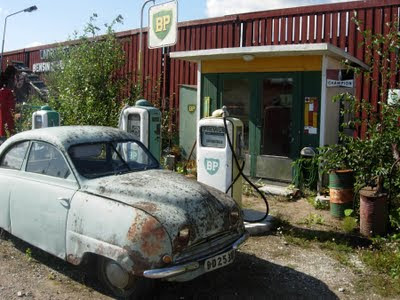 A photo of IKEA founder Ingvar Kamprad that I took when I met him in 2008.
A photo of IKEA founder Ingvar Kamprad that I took when I met him in 2008. Today the Swedish media is focusing on the wartime years of IKEA founder Ingvar Kamprad. Yesterday evening, secret-stamped Swedish police documents about Kamprad were shown in prime time Swedish TV (SVT) news.
The new documents, found by journalist/author Elisabeth Åsbrink, say that Kamprad was, at least in 1943, a full member (party member number 4014) of the Swedish-Socialist Assembly, in Swedish Svensksocialistisk Samling (SSS), and also active within its youth wing Nordic Youth, Nordisk Ungdom (NU). ADDED 8-31: However, this is not as sensational as it may sound. Ingvar Kamprad in 1998 stated himself that he in his youth probably became a full member of the SSS but that he could not recall when he did this.
There is one English-language book that provides some facts about what kind of party the SSS was. That book is Swedes at War, by yours truly and Lennart Westberg (see the above book cover). Our book describes the character and history of the party in the chapter about Swedes in German WWII uniform, as the majority of the 200 individuals that served in the Waffen-SS or Wehrmacht belonged to the SSS.
Just how Nazi was the SSS? As we state in our book the SSS was without doubt national socialist in character. However, within Nazism there were factions and even opponents to Hitler (or Hitlerism). So, although the SSS was close to the ideology of Hitler and his party (NSDAP), it also made some notable gestures such as dropping National Socialist in its name in 1938, replacing it with Swedish-Socialist (in Swedish a single word: Svensksocialistisk). The same year the party stopped using the swastika, replacing it with a Vasa sheaf (vasakärve). The brown shirts were replaced by blue ones.
Thus Ingvar Kamprad most probably never wore a swastika armband, swastika pin or SA-brown shirt.
 The main newspaper of the SSS during WWII was "The Swedish Folk Socialist".
The main newspaper of the SSS during WWII was "The Swedish Folk Socialist". Perhaps more significantly, three members of the SSS movement fought against the Germans when Hitler invaded Norway in 1940. At least one of them also died there, killed in action by a German hand grenade. His name was Karl Lindström and he is also described in Swedes at War. While the German invasion of Norway was taking place these volunteers had the support of their party. BTW, zero Swedes fought for the Germans in Norway 1940.
In addition it can be mentioned that there existed other Nazi groups in Sweden, more radical and closer to the German NSDAP, such as Solkorset, meaning the Sun Cross.
Nevertheless, the SSS remained, also after 1938, basically a national socialist movement. Why was Kamprad attracted by it? Let us bear in mind that Kamprad's father was German and his German grandmother an ardent supporter of Hitler.
Also, let us not forget that during the 20th century no Nazi party won a single seat in the Swedish parliament. The latter fact also became apparent during WWII when only 200 Swedish citizens donned German uniforms - which can be compared with the more than 1,000 Swedish citizens that joined various military units on the Allied side (mostly for Norway). And one ought not to forget the about 8,000 Swedish citizens that served on merchant vessels on the Allied side. ADDED 8-31: Finally, and perhaps most important for today's perception of Ingvar Kamprad, it should be noted that Mr. Kamprad in the 1998 book about his life rejected both nazism, fascism and racism.
















